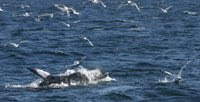Wowee! What a day! The shelf edge was as exciting as I was hoping, and it felt a bit like the last day of school, the way everyone was grinning all day.

I, Beth & the birders managed to force ourselves up for dawn (around 5:30am) – this was unusual for me, but not for Beth (with her dawn bongo nets), nor for the birders (who are up nearly every day at dawn looking for birds). Apart from getting up ridiculously early (yawn) it's a lovely time of day to be awake - we had a lovely sunrrise (see picture to right) - it dawned a glorious sunny day with calm blue seas… perfect for whale-spotting. As we approached the shelf edge, lines of surface slicks (one indication at the surface of internal waves beneath the sea surface) appeared on the horizon, and soon we were in amongst the slicks and on cue lots of storm petrels appeared, picking food from the surface (a couple are pictured below).


We stopped close to the shelf edge for a few CTD stations, bongo net deployments to see how different the shelf edge is from the area on and around Jones Bank, and some sediment grabs (Nick happily found lots of worms in the sandy substrate). Meanwhile, the birders threw over ‘chum’ made with the soggy remainder of the mackerel Inigo had left over as bait for his camera, mixed in with sunflower oil & cornflakes.

They wanted to make sure that they got some interesting birdy sightings at the shelf edge. As I popped out onto the back deck, all three birders turned and beckoned, grins on their faces and gleams in their eyes like little schoolboys… ‘it’s a Wilson’s storm petrel!’ they exclaimed. I grabbed Andy’s soggy mackerel encrusted binoculars, but there were so many European storm petrels surrounding the ship, dip feeding on the chum, that I couldn’t pick it out. But I did spot some feeding common dolphins again! Everyone who wasn’t working was on the deck enjoying the sunshine, the dolphins and the storm petrels (see picture on right).
For the next station we were going over the edge… into water 3000m deep – it dropped off so quickly – an odd feeling to know that you’re essentially going over the edge of an underwater cliff, and hovering up above. En route, many of us were busy with polystyrene cups writing messages & drawing silly pictures, and tying them onto the outside of the CTD. What on earth is this silly ritual? Well, the CTD was going to be sent into the abyss… to be lowered on the wire down to nearly 2000m to measure the temperature & salinity through the water column, and to collect water samples for ‘muf’ Clare to analyse. At such depths, anything with air in it is squished small by the huge pressure of the water sitting above it – so hey presto – our large polystyrene cups are turned into miniature souvenirs of the trip (see before and after pictures below).


But the main excitement of going over the edge was the whales… it wasn’t long before the first blow of a whale was spotted – this looks like a big tall plume of steam – which it is more-or-less, but it’s actually very smelly fishy watery breath of the whale that it spurts out of its blow hole on the top of its head when it comes up to breath after a long dive under the sea to feed. You can see these blows for miles – right up to the horizon. And if you’re lucky (we were), after the blow, you’ll see the long black back, and finally the dorsal fin (the sharp fin on its back) – this was a fin whale. And the first of many – for the whole 5 hours that we were over the abyss, we were surrounded by the blows of fin whales. Inigo and I stood up at the birders boxes for hours marvelling at the magnificence of these beasts. And as the sun began to set, the birders (Andy, Mark & Adam) & Beth also came up with some cans of beer, and we sat in the opera boxes and toasted a great day (see photos below)… and were rewarded with the green flash!!!
 Adam, Andy, Mark, Beth & Inigo toasting the green flash over the abyss
Adam, Andy, Mark, Beth & Inigo toasting the green flash over the abyss
The green flash, for any of you lucky enough to see it, occurs as the sun is just sinking over the horizon, and fills with a bright bursts of green colour as it disappears… this is the green flash – and it’s spectacular to see. The scientific explanation of the green flash can be found at the Wikipedia
here.
...and I was going to end the blog today on that note, but just as I was going to press the birders spotted a pod of killer whales on the starboard bow!!!! Now, I've never seen a killer whale in the wild in my life, despite many hours at sea, so I was OVER THE MOON!!!! I was so absorbed watching the 3 female adults, 2 wee calves and nice hefty male with a nice tall dorsal fin, that I didn't take any photos - sorry! But I do have a nice sunset photo to end on:
 the Aberdeen crowd celebrating the end of a magnificent day
the Aberdeen crowd celebrating the end of a magnificent daySo we're now steaming for Falmouth to offload - so the last blog of the cruise might be a bit delayed in all the kerfuffle... but so far it's been a fantastic finale to the trip :o)
















